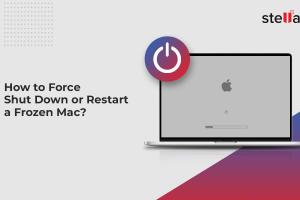Ultimate Guide to Force Shut Down or Restart a Frozen Mac: Step-by-Step Solutions

-
Quick Links:
- Introduction
- Understanding Why Your Mac Freezes
- Common Causes of a Frozen Mac
- Prevention Tips for Mac Freezing
- Methods to Force Shut Down or Restart a Frozen Mac
- What to Do After Restarting Your Mac
- Troubleshooting Common Issues
- Expert Insights
- Case Studies
- FAQs
Introduction
Every Mac user has faced the frustration of a frozen screen at some point. Whether you are working on a crucial project or simply browsing the web, a sudden freeze can be a major inconvenience. This comprehensive guide will walk you through various methods to force shut down or restart a frozen Mac, ensuring your device runs smoothly in the future.
Understanding Why Your Mac Freezes
A frozen Mac occurs when the operating system becomes unresponsive due to various factors. Understanding what leads to this situation can help you prevent it from happening again. When a Mac freezes, it typically means that the system is unable to execute commands, which can be caused by hardware or software issues.
Common Causes of a Frozen Mac
- Insufficient RAM for running applications
- Software bugs or glitches
- Corrupted system files
- Incompatibility between applications
- Overheating due to blocked vents or heavy usage
Prevention Tips for Mac Freezing
To minimize the chances of your Mac freezing, consider the following preventive measures:
- Regularly update macOS and applications to the latest versions.
- Monitor memory usage through the Activity Monitor.
- Clear cache files to free up disk space.
- Run regular maintenance checks using built-in tools.
- Ensure proper ventilation and avoid overheating.
Methods to Force Shut Down or Restart a Frozen Mac
When your Mac becomes unresponsive, you may need to force it to shut down or restart. Here are several methods you can follow:
Method 1: Using the Power Button
This is the simplest way to force shut down your Mac:
- Press and hold the power button for about 10 seconds.
- Your Mac should turn off. Wait a few seconds and then press the power button again to restart.
Method 2: Using Keyboard Shortcuts
Keyboard shortcuts can also help in these situations:
- Press Command + Control + Power to force restart.
- Press Command + Option + Esc to open the Force Quit Applications window. From there, select the unresponsive application and click "Force Quit".
Method 3: Resetting the SMC
If your Mac continues to freeze, resetting the System Management Controller (SMC) may help:
- Shut down your Mac.
- For MacBooks with T2 chips, press and hold the right Shift, left Option, and left Control keys for 7 seconds. While holding these keys, press and hold the power button for another 7 seconds.
- Release all keys and turn on your Mac.
Method 4: Safe Mode Boot
Booting into Safe Mode allows you to troubleshoot:
- Shut down your Mac.
- Press the power button and immediately hold the Shift key until you see the login window.
- Log in and see if the issue persists.
What to Do After Restarting Your Mac
Once your Mac has restarted, it’s essential to check for any underlying issues:
- Check for software updates.
- Run Disk Utility to fix any disk errors.
- Review the Activity Monitor for any applications consuming excessive resources.
Troubleshooting Common Issues
If your Mac continues to freeze after restarting, consider these troubleshooting steps:
- Uninstall recently added applications that may be causing conflicts.
- Check for malware using reputable antivirus software.
- Consider reinstalling macOS as a last resort to fix persistent issues.
Expert Insights
Experts recommend regular maintenance and keeping your operating system updated to avoid freezing issues. According to a survey by Macworld, 70% of users experienced freezing due to outdated software or lack of updates.
Case Studies
In a study conducted by Apple Support, users reported that implementing regular maintenance checks reduced the occurrence of frozen screens by 50% over six months. This indicates the importance of proactive measures in maintaining system performance.
FAQs
1. What should I do if my Mac is frozen and won’t turn off?
Try holding the power button for 10 seconds to force a shutdown.
2. Can I lose data when force shutting down my Mac?
Yes, unsaved work may be lost if you force shut down your Mac.
3. How do I know if my Mac is frozen or just slow?
If the cursor doesn’t move and applications won’t respond for several minutes, your Mac is likely frozen.
4. What is the best way to prevent my Mac from freezing?
Keep your software updated and monitor system resources regularly.
5. Can overheating cause my Mac to freeze?
Yes, overheating can lead to performance issues, including freezing.
6. Is there a way to recover unsaved files after a crash?
Check the AutoSave features of applications or use recovery software for potential retrieval.
7. How often should I perform maintenance on my Mac?
It’s advisable to perform maintenance checks every few months, or more frequently if you notice issues.
8. What are some signs of a failing hard drive?
Unusual noises, frequent crashes, and slow performance can indicate hard drive failure.
9. Should I use third-party software to fix my Mac?
Use caution with third-party software; only choose well-reviewed options from reputable sources.
10. When should I seek professional help for my Mac?
If the problem persists despite troubleshooting, it’s best to contact a professional technician.